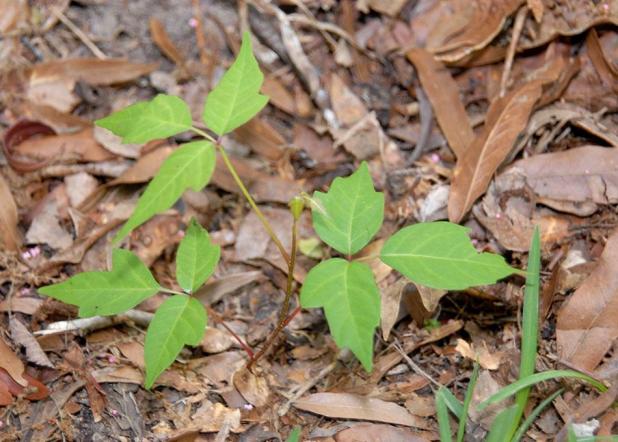
Poison ivy may be hidden in the yard or garden. Handle plants removal with care.
—LSU AgCenter/Rick Bogren
Get It Growing: Don’t let poison ivy take hold
I recently came across some poison ivy as I was working in an out-of-the-way area of my landscape. Poison ivy is very abundant in urban, suburban and rural landscapes. I keep a sharp eye out for this plant as I’m quite allergic, and I promptly and ruthlessly deal with any as soon as I see it.
RECOGNIZING POISON IVY
Poison ivy is a tall, climbing vine that is leafless in winter. As it climbs tree trunks, wood fences or other flat structures, the stem produces many small roots that cling to the surface. This is a good identifiable characteristic of the vine in case you can’t easily see the leaves. These plants are quite common along fences and at the base of trees, and seedlings are often found in garden beds.
Poison ivy has a characteristic compound leaf consisting of three leaflets (Hence the saying, “Leaves of three, let it be.”) The leaves are 2- to 4-inches long and dull or glossy green with pointed tips. The middle leaflet is generally larger than the two laterals. The margins of the leaflets are variable, appearing irregularly toothed, lobed or smooth. The leaves are arranged alternately on the stems. Young foliage is often shiny or oily-looking with a reddish tint.
Mature poison ivy vines growing up trees flower and produce a white fruit which is readily eaten by birds. The birds spread the seeds through their droppings, creating the wide occurrence of this plant. New seedlings of poison ivy are easily overlooked. They may have a reddish tint to their foliage and will appear upright. As they get older, they will begin to vine and grow up nearby shrubs or trees. It is easy to come into contact with young poison ivy seedlings when weeding flower beds, so you need to be observant.
Another common vine in our area, Virginia creeper (Parthenocissus quinquefolia), is a non-poisonous vine that is often mistaken for poison ivy. It has five leaflets radiating from one point of attachment on mature leaves, which distinguishes it from poison ivy which has three. The leaflets also have a different marginal appearance.
CONTROLLING POISON IVY
In controlling poison ivy, one of the most important things to do is to periodically check your landscape carefully for seedlings or vines. Look for the three-leaflet leaves in out-of-the-way areas, under shrubs, along back fences and by trees.
Three methods can be effective in eradicating poison ivy in landscapes.
The first is hand pulling or digging them out when the soil is moist; getting out as much of the roots as possible. Use long gauntlet rubber gloves available at local hardware stores or dishwashing gloves when handling the vines. Place the plants into a plastic bag, seal it (in consideration for trash collectors) and throw it away. Be sure to wash your gloves with soap and water after handling poison ivy.
The second is to carefully spray the foliage with a systemic herbicide. This is only possible when the spray will not get on the foliage of desirable plants. If needed, nearby desirable plants can be covered with plastic sheets or bags to protect them while you do the spraying. Be sure to wet the foliage of the poison ivy vine thoroughly. Systemic herbicides are absorbed by the foliage and enter the plant’s circulatory system, which sends the material into the vine’s roots, killing them as well. Glyphosate (Roundup, Eraser, Hi-Yield Killzall and other brands) or triclopyr (Brush-B-Gon, Brush Killer and other brands) are commonly recommended for poison ivy control. Herbicides that contain combination of dicamba (banvel) and 2,4-D also work well. Once the vine dies, it may be removed. The dead leaves still contain the rash-causing oils and should be handled cautiously with gloves.
The third method is for larger, established vines growing up in trees or intertwined in shrubs. Spraying the vine foliage is not practical in these situations because of the potential to injure desirable trees and surrounding landscape plants. Poison ivy control in sensitive areas can best be achieved by the cut vine method.
Cut off the vine a few inches from the ground with loppers and immediately treat the surface of the freshly cut stump with undiluted triclopyr (Brush B Gon, Brush Killer, Greenlight Cut Vine and Stump Killer and other brands). The vine in the tree or shrubs will die because it has no root system. The treated stump will die because the herbicide gets absorbed by the freshly cut surface and translocates to the roots. Applying the herbicide to the fresh cut is necessary because it prevents the stump from resprouting. This method is quite effective and may be used any time of the year.
Getting poison ivy off your property will probably take repeated herbicide applications. Older vines in neighboring yards may continue to drop seeds in your landscape. Watch out for this unwelcome plant and be prompt and aggressive in your efforts to control it.
